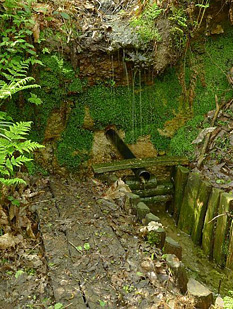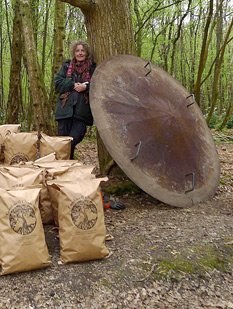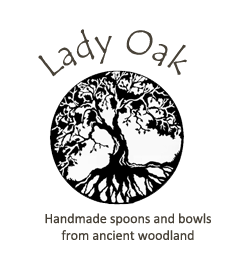



"In a far corner of a remote woodland estate on the borders of Kent and Sussex lies a small wood called Lady Oak wood. The name of the estate is Combwell Woods, but Lady Oak Wood hasn't always been included within its boundary. On looking at the Manor of Combwell maps dated 1622 it is noticeable that Lady Oak came within the boundary of New Rayle woods. These maps, therefore, provide documented evidence that LadyOak forms part of a very large and ancient woodland.
On close inspection of the maps, it can be noticed that a spring once ran through these woods. If any such spring stills exists it lies within the area of the nearby North wood, (which along with South Wood and, the aptly named New Rayle Wood make up the same area today as that which was mapped in 1662). The Woods are steeped in history and lore. There is evidence of iron smelting, charcoal burning and coppicing. It is also thought that the woods were once the property of a nearby abbey. The 'Combe 'from Combwell is said to originate from the Jutish period and quite possibly they word ‘Rayle’ comes from the same roots, however more investigation needs to be undertaken in respect of this."
Witney, K.P. (1976) The Jutish Forest. A study of the Weald of Kent from 450 to 1380 AD. Athlone Press.
Excerpt from the ‘Core Monument Record & Report by Dr Nicola R. Bannister AIfA:
"Conclusions: As this initial site visit and reconnaissance of the archives has shown, Combwell Woods is a site with a wealth of archaeological features from at least the medieval period through to the modern. The preservation of archives for this part of Kent is extensive due to there being a number of landed gentry, owning large areas in the 19th century, namely the Husseys of Scotney, Beresford Hopes of Bedgebury and the Campions of Danny.
A systematic search and recording of these archives is also strongly recommended. There does however need to be a systematic archaeological and archive assessment in order to identify and record any further features for future management and conservation.
The wider historic landscape context of Combwell is also of interest as it lies close to the county boundary with Sussex and its origins as former dens or swine pastures is of considerable interest in relation to nearby Bedgebury and Scotney, where the practice of pannage may have been practiced well after the Conquest.
Future Recommendations: As already mentioned above, in order to fully understand the extent, history and chronology of the earthworks preserved in Combwell Woods, a Level 2 Landscape Archaeology Assessment60 is strongly recommended to be undertaken for the whole of the woodland complex, under the guidance of a professional landscape archaeologist. Such an assessment will provide a sketch plot map of all the known features, together with summary descriptions and management guidelines.
In addition a more detailed search of the archives will draw together information on the features together with the history of the development of the landscape at Combwell Woods. It will also place the individual features in each of the owner’s woods in their wider historic landscape context. The Owners together with the Kent High Weald Partnership and the Cultural Heritage Adviser of the High Weald AONB have already begun this process by commissioning this piece of work which can be seen as an initial scoping exercise highlighting the archaeological potential of Combwell Woods."
On coming to Lady Oak Wood, Sue found the area to be smothered in Rhododendron, this has largely been removed now to reveal the true character of Lady Oak. It also has a mature pond and an extensive area of regenerating coppice, both of which are a haven for wildlife. The value of these woods is in their diversity. Lady Oak wood includes Sweet chestnut, Oak, Ash, Birch, Elder, Rowan, Alder, Hazel, Willow, Hawthorn and Beech. Amongst the ground flora there is Bluebell, Alum and Dogs Mercury.
There is lots of evidence of old workings within the woods including the remains of the workings of the last charcoal burner that was known to have been working in the earlier part of last century. The photo shows what is left of his workings. He was known to have been doing earth burns and a record of his life has been made in a local history book.
There is also evidence of extensive workings taking place during the years of the second world war. Most of this work would have been carried out by the Land Girls or the Women's land army, and it is believed that wood from here was cut and laid down as track for the D-day landings.
The woods are also covered by a series of ancient drainage ditches and ditch and bank boundaries can be found in many places. In addition to this pond workings and redundant charcoal burner's hearths can be found indicating that this area has a long history of use, probably tied in with the Wealden iron industry. Alexander Culpeper owned the forge at Bedgebury where the local workforce produced cannons that defeated the Spanish Armada in 1588.
During the Roman occupation of Britain the area came within the bounds of the Forest of Anderida, the area was said to have been sparsely inhabited and inhospitable with the majority of people living on the fringes of the great forest. Since the Iron age the area has also been crossed by droveways and pannage tracks where livestock owners drove their animals to summer feeding pastures.
The forests of the Weald were often used as a place of refuge and sanctuary.
From the Anglo-Saxon chronicles:
“A.D. 477 This year came Aelle to Britain, with his three sons, Cymen, Wlenking, and Cissa, in three ships; landing at a place that is called Cymenshore. There they slew many of the Welsh; and some in flight they drove into the wood that is called Andred'sley.”
Until the late Middle Ages the area was a notorious hangout for smugglers, bandits, highwaymen and outlaws. A band of smugglers called the Hawkhurst gang were notorious in the area. They met their end in a battle at Goudhurst in 1735 where the local residents recruited a former army corporal, William Stuart, to bring the ringleaders of the gang to justice. They were executed and hung on gibbets at Horsmonden and Hurst Green.



